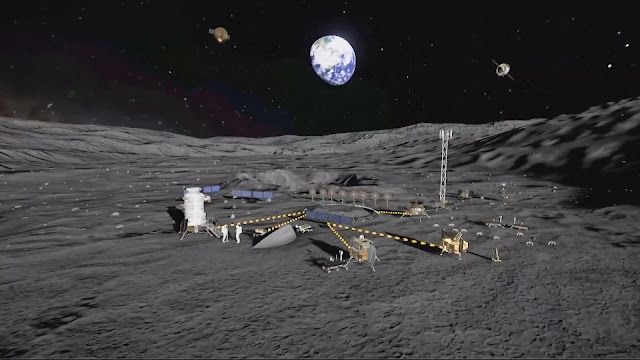CLEP - China Lunar Exploration Program logo.
April 28, 2023
China is Planning to Land Humans on the Moon by 2030 as Part of its Ambitious Lunar Agenda
Image above: Image from a video animation showing the lunar research station discussed by the CLEP Chief Designer, Weiren Wu. Image Credit: China Media Group.
Weiren Wu, the Chief Designer of the Chinese Lunar Exploration Program (CLEP), recently announced an ambitious plan to put Chinese footprints on the lunar surface by 2030. This announcement came just prior to this year’s Space Day of China, an annual event celebrated on April 24th meant to showcase the space industry achievements of the China National Space Administration (CNSA).
“By 2030, the Chinese people will definitely be able to set foot on the moon. That’s not a problem,” Wu said in an interview with China Media Group (CMG). This most recent announcement comes less than a year after CLEP was given state permission by China to begin Phase-4 of CLEP, whose program structure consists of four phases of robotic lunar exploration, with the first three phases having achieved a flawless success rate.
Phase 2 consisted of three missions, the first of which was combination lunar lander and rover, Chang’e-3, that launched in December 2013 and is currently active. The second mission was Queqiao-1, which was launched in May 2018 to serve as a relay satellite sent to the Earth-Moon L2 Lagrange Point for communications relay with Chang’e-4, which was launched in December 2018 and was a combination lunar lander and rover, the latter of which was dubbed Yutu-2. This also marked the first soft landing on the far side of the Moon in history.
Phase 3 consisted of two missions, the first the experimental test flight, Chang’e-5 T1, which was launched in October 2014 and was designed to test the various rendezvous and capsule technologies that would be required for a lunar sample return mission, which was accomplished with Chang’e-5 in late 2020 as it successfully returned 1731 grams of lunar regolith to the Earth.
Phase 4 will consist of four missions, the first of which will be the Queqiao-2 relay satellite that is scheduled to be launched in 2024 and will act in the same manner as its predecessor for remaining Phase 4 lunar missions, Chang’e-6, -7, and -8, which are scheduled to be launched in May 2024, 2026, and 2028, respectively.
“There’s a relay satellite up there, whose main function is to solve the communication problem between the Earth and them, and also support Chang’e-7 and Chang’e-8, as they will land in different locations,” said Wu.
Wu also discussed how Chang’e-6, slated to be another lunar sample return mission, will be both collecting and returning lunar samples from the far side of the Moon in 2024. He notes this will be the first time in history that lunar samples from the far side of the Moon will be returned to Earth. The Chang’e-7 mission will travel to the south pole of the Moon with the primary objective of searching for hints of water that might be located there.
“The international lunar research station built by China is open (to international partners),” Wu said. “We welcome the participation of developed countries such as the United States and European countries. We also hope that BRICS countries and some underdeveloped African countries will join us. We have put forward an initiative for all to sign contracts, deals or strategic agreements of intent.”
Along with making incredible strides in lunar exploration, China also has an active space station, Tiangong, which will be a four-module platform in low Earth orbit when fully-assembled, with the third and most recent module, Mengtian, having been launched in October 2022, and the final module, Xuntian, currently scheduled to launch in 2024.
Related articles:
China unveils lunar lander to put astronauts on the Moon
https://orbiterchspacenews.blogspot.com/2023/02/china-unveils-lunar-lander-to-put.html
Related links:
Chinese Academy of Sciences: https://english.cas.cn/
China National Space Administration (CNSA): http://www.cnsa.gov.cn/english/index.html
China space white paper: http://www.cnsa.gov.cn/english/n6465652/n6465653/c6813088/content.html
Images (mentioned), Videos, Text, Credits: CNSA/CAS/CCTV/SciNews/Orbiter.ch Aerospace/Roland Berga.



